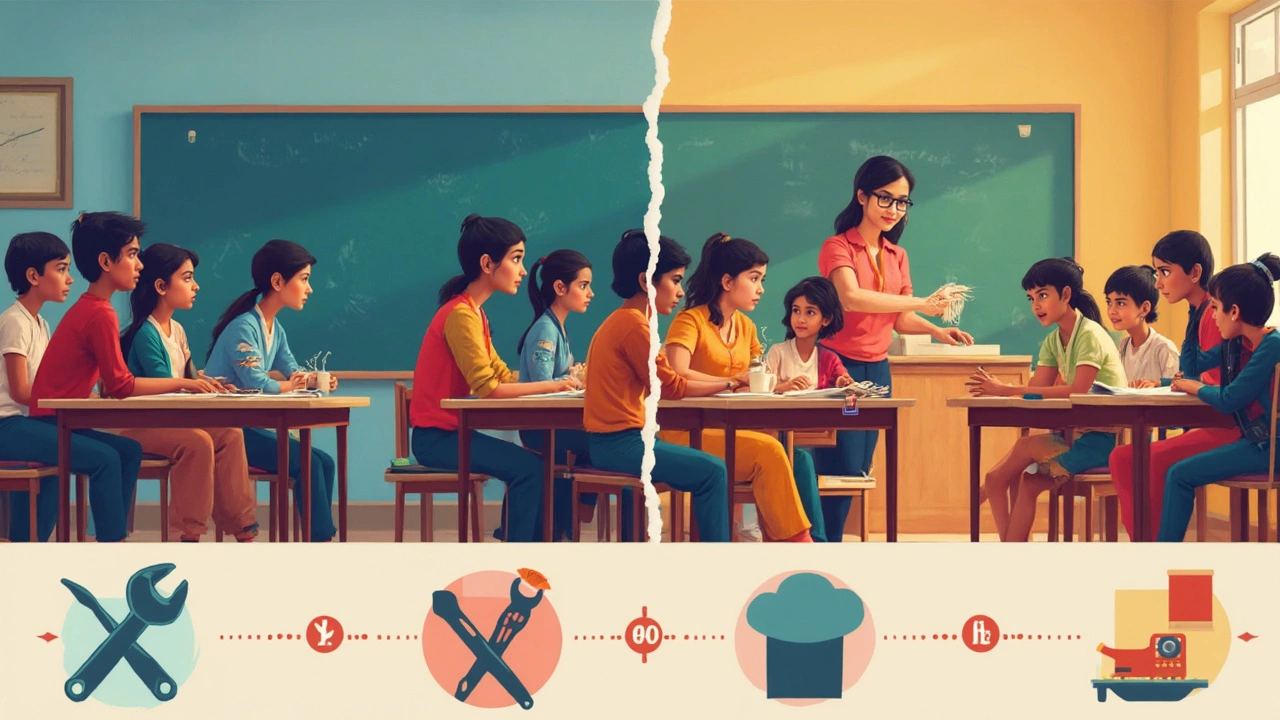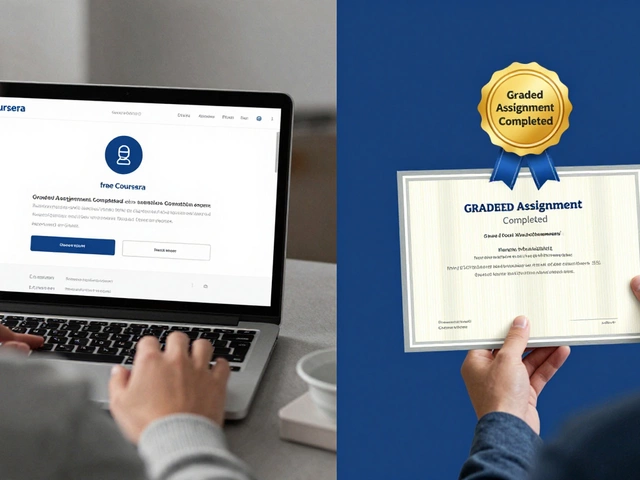Ask any teenager about their school day, and you’ll probably hear about math, English, or gym. But start talking about vocational classes, and things get interesting, fast. Vocational in school basically means learning practical skills for a real job—think electrician, chef, auto mechanic, or nurse—while you’re still getting your regular education.
Unlike academic classes where you tackle algebra or write book reports, vocational programs teach you things you can use right away, like wiring a house, fixing a car, or preparing a restaurant-style meal. No abstract theories—just hands-on, real-life training that can lead straight to a job, sometimes before you even graduate.
This isn’t just for kids who “don’t like school.” Plenty of students choose these paths because they want to learn by doing, not just listening. And with the job market these days, more companies are desperate for people with specific skills—not just a high school diploma and a stack of textbooks. Vocational classes can even mean earning industry certificates before leaving high school, giving you a head start if college isn’t your thing.
- What Does 'Vocational' Actually Mean?
- How Vocational Courses Work in Schools
- Who Should Think About Vocational Programs?
- Common Types of Vocational Training in Schools
- Is Vocational Education Worth It?
What Does 'Vocational' Actually Mean?
When you hear the word vocational in school, think about jobs and careers instead of textbooks and essays. A vocational program teaches you specific skills for a particular job or trade—usually the kind of work you can jump into right after high school, without a four-year degree.
Here’s how it breaks down: while most high school classes focus on general knowledge, vocational education drills down into hands-on training. You’re not memorizing random facts; you’re learning how to do something real, like fixing engines, designing websites, or running a small business. It’s launched right in school, so students don’t wait until college or after graduation to start learning work skills.
Vocational courses often come with actual certifications or licenses. For example, a student taking a health sciences track could leave school already certified as a nursing assistant, or someone in a culinary program might have a food handler’s license in hand. According to the National Center for Education Statistics, more than 7 million US high school students took at least one career and technical education course last year. That’s not just a trend—it’s a major part of how modern high schools are set up.
Vocational training covers a big range of fields:
- Healthcare (nursing assistant, dental tech, pharmacy tech)
- Construction trades (carpentry, electrician, plumbing)
- Manufacturing and automotive repair
- Information technology (coding, network support)
- Hospitality (chef, event planner, hotel management)
The big idea: vocational means school classes that zero in on a possible career, giving you a head start before you even walk across the graduation stage.
How Vocational Courses Work in Schools
Vocational courses in schools are designed to give students real skills for real jobs, and they do things pretty differently from regular school classes. Instead of just sitting at desks all day, students actually jump in and practice what they're learning. You might spend half the day in a regular English or math class, then the rest in a workshop, kitchen, garage, or lab—where things get seriously hands-on.
Most vocational programs partner up with local businesses, trade groups, or community colleges. That means students get access to proper equipment and training. Sometimes, a student might even spend a few days a week working at a job site as part of their school day, getting high school credit and racking up job experience at the same time.
If you’re in a state like Texas, Florida, or California, there are big, well-developed vocational courses. Schools might offer options like:
- Automotive repair, where students fix real cars
- Health sciences, with training to become a nursing assistant
- Culinary arts, learning in actual kitchens with real customers
- Construction trades, from carpentry to welding
- Information technology, with hands-on coding and network setups
Here’s a unique thing: many vocational high school programs let you earn industry-recognized certificates before graduation. For example, students studying automotive technology could leave high school with certifications from ASE (Automotive Service Excellence)—so they’re ready to land jobs right away.
Let’s break down a typical week with a quick snapshot:
| Day | Morning | Afternoon |
|---|---|---|
| Monday | Math, English | Automotive Shop |
| Tuesday | Science, Social Studies | On-Site Job Shadowing |
| Wednesday | Math, Health | Automotive Shop |
| Thursday | English, History | Certification Study |
| Friday | Lab (Engines, Electronics) | Resume & Interview Skills |
So, vocational courses aren’t just an extra elective—they’re structured to fit right alongside normal academics. That means by the time students finish, they’ve got both a diploma and practical, valuable career training. In some cases, they even finish with job offers from companies they've worked with during these programs.

Who Should Think About Vocational Programs?
You don’t have to “hate” school or struggle in academic classes to fit into a vocational program. These courses make sense for all sorts of students. If you’re someone who likes building, fixing, cooking, creating, or just learning by doing—this might be a game-changer. For example, my daughter Orla can barely sit through a long lecture, but when she picks up tools in a workshop, she’s all in.
If you’re looking to skip the four-year college grind, or just want to start working right after high school, vocational courses could make a lot more sense. Sometimes the pay for skilled trades (like electrician or HVAC technician) is higher than starting office jobs for college grads—plus, you avoid massive student loans. According to the U.S. Bureau of Labor Statistics, skilled trades like plumbing, electrical work, and some health support roles are actually growing faster than many office jobs. Check out this quick comparison:
| Job | Growth Rate (2023-2030) | Median Salary (2024) |
|---|---|---|
| Electrician | 6% | $61,500 |
| Nursing Assistant | 8% | $35,800 |
| General Office Clerk | 2% | $36,600 |
It’s not just about money, though. Some students just want a more direct path—less theory, more action. If you like solving real-world problems or want to work with your hands, that’s a solid reason to give vocational training a shot.
- Kids who want practical, hands-on skills
- People who learn better by doing rather than reading
- Students aiming for jobs with high demand right now
- Anyone looking to get certified before even finishing high school
- Teens who want work experience and a paycheck sooner
These programs aren’t “easier” than regular school—they’re just different. You’ll learn the nuts and bolts of a trade, pick up on-the-job habits, and show up ready for real work. If any of these points hit home, it might be time to take a closer look at vocational courses in your school.
Common Types of Vocational Training in Schools
Walk into any high school that offers vocational programs and you’ll see just how broad this stuff is. These aren’t the old shop classes our parents remember—today’s courses are loaded with serious career options and modern equipment. You’ll find training in jobs that never go out of style, plus new ones that didn’t exist ten years ago.
Here are some of the big hitters when it comes to vocational courses at the high school level:
- Automotive Technology: Not just oil changes. Students learn diagnostics, engine repair, and how to work with computer systems in modern cars.
- Culinary Arts: More than baking cookies—think working in commercial kitchens, food safety, nutrition, and even restaurant management basics.
- Health Sciences: Lots of schools now offer programs leading to certifications like CNA (Certified Nursing Assistant). Students practice real skills in first aid, patient care, and even shadow nurses in clinics.
- Construction Trades: Plumbing, carpentry, electrical work—students often build models at school, but some even work with local businesses for on-the-job practice.
- Information Technology: Think coding, cybersecurity fundamentals, networking, and hardware repair. Some programs set students up for IT certifications right after high school.
- Welding and Manufacturing: From blueprints to working with heavy machines, students in these classes graduate ready to walk straight into a factory, workshop, or job site.
- Cosmetology: Not just makeup—students practice cutting hair, doing nails, and skin care treatments, logging enough hours to take licensing exams early on.
If you’re curious which paths are popular, check this out:
| Vocational Area | Estimated % of Students Enrolled (U.S.) |
|---|---|
| Health Sciences | 16% |
| Automotive Technology | 12% |
| Construction Trades | 10% |
| Culinary Arts | 8% |
| Information Technology | 7% |
There are also other cool options popping up, like video production, animal science, firefighting, and emergency medical responder courses. Your local high school might offer something totally unexpected—don’t be afraid to ask.
One tip: if you already know which career path gets you pumped, check if your school partners with technical colleges or local companies. This could mean earning both school credit and real-world experience at the same time. Getting that jump on certifications or apprenticeships can save you a ton of time, and sometimes cash, after graduation.

Is Vocational Education Worth It?
If you’re thinking about taking vocational courses in school, you probably want to know if it actually pays off. The short answer? For a lot of students, yes. It’s not just hype—there are some solid facts to back this up.
First, a bunch of jobs out there don’t require a four-year college degree, but they do need real skills. A 2024 survey by the National Skills Coalition found that almost 50% of job openings in the U.S. are for “middle-skill” roles—like medical assistants, electricians, and mechanics—that you can prep for in high school or fast-track programs. That means you could finish school and jump right into a job that pays pretty well, without a mountain of college debt.
Here’s what makes vocational education worth it for many students:
- Real-World Experience: You get hands-on training, sometimes even on real job sites or through internships. Learning by doing makes a huge difference—ask anyone who’s fixed a car instead of just reading about engines.
- Industry Certifications: Schools often work with local companies, so you can earn certifications that matter to employers. These are like tickets straight to a job interview.
- Shorter Path to Work: Most vocational courses wrap up faster than college degrees. Some programs finish in one or two years, right alongside your regular schoolwork.
- High Demand Jobs: The U.S. Bureau of Labor Statistics says jobs like HVAC techs, welders, and dental hygienists—classic vocational jobs—are growing faster than many office roles. Companies need these skills, now.
- Saves Money: Skipping or shortening college cuts down on tuition and means you start earning sooner. That’s a big deal for lots of families and students.
Check out these real numbers from the U.S. Department of Education (2024):
| Career Area | Median Salary with Vocational Training | Job Growth (2022–2032) |
|---|---|---|
| Electrician | $61,590 | 6% |
| Dental Hygienist | $81,400 | 7% |
| Automotive Technician | $49,400 | 2% |
| Medical Assistant | $38,270 | 14% |
Not every student should choose vocational education—if you want to be a doctor or a lawyer someday, college will still be the way. But if you want to start working sooner, build job skills while you’re in school, or avoid the crazy cost of university, vocational paths can make a ton of sense.




